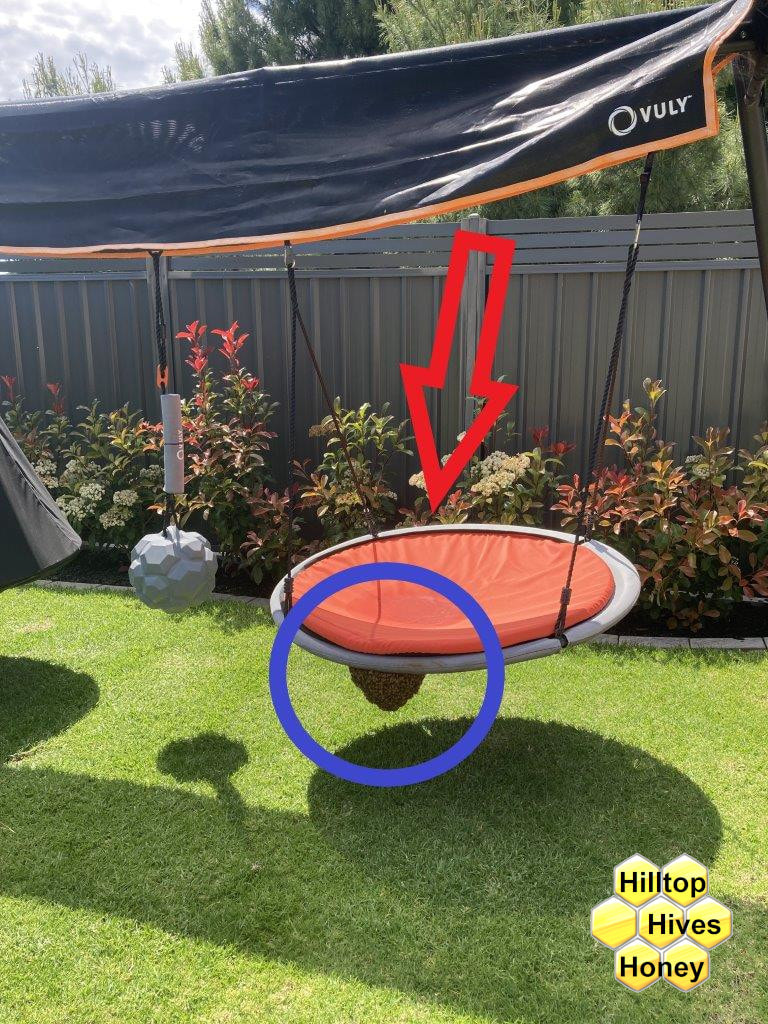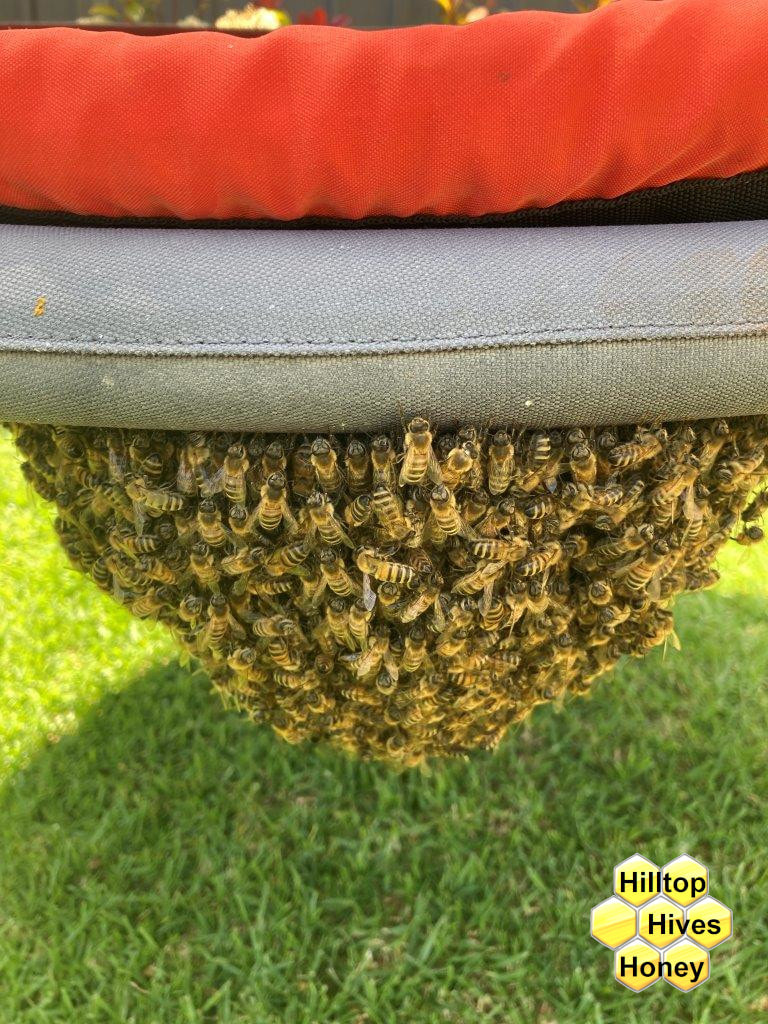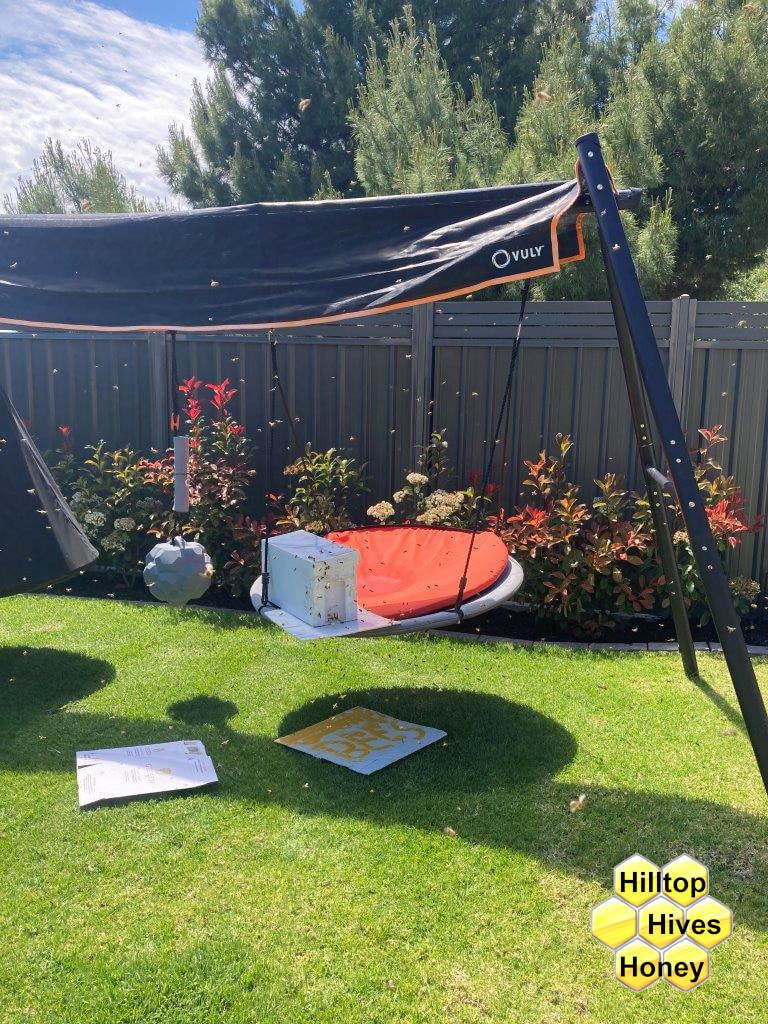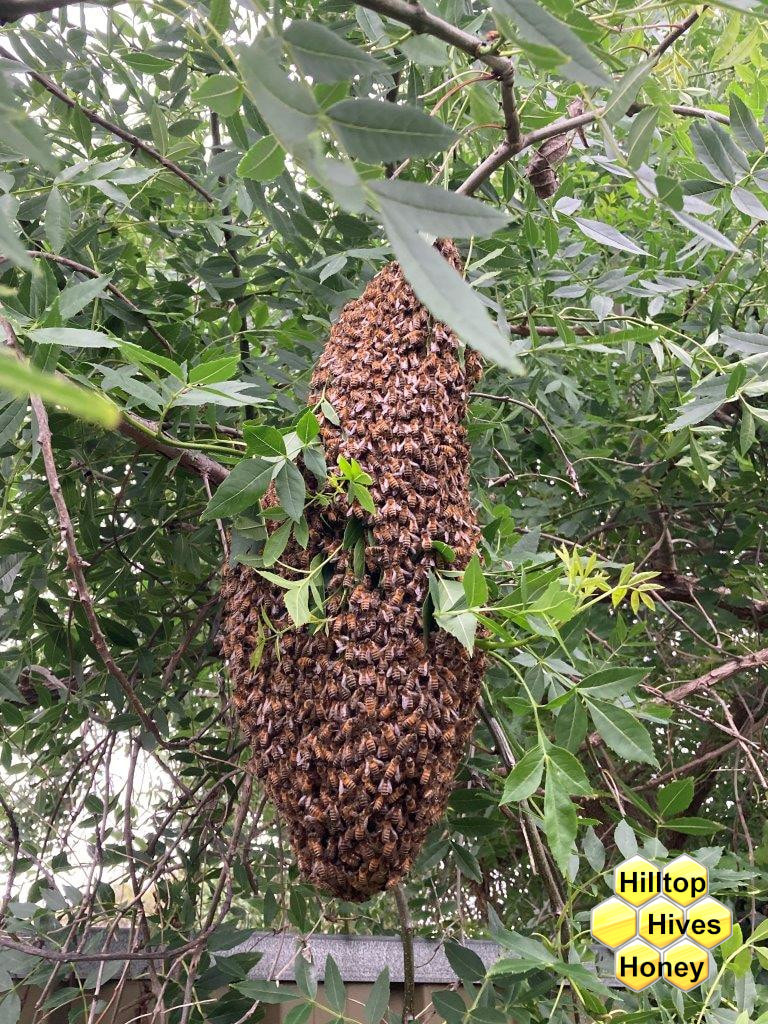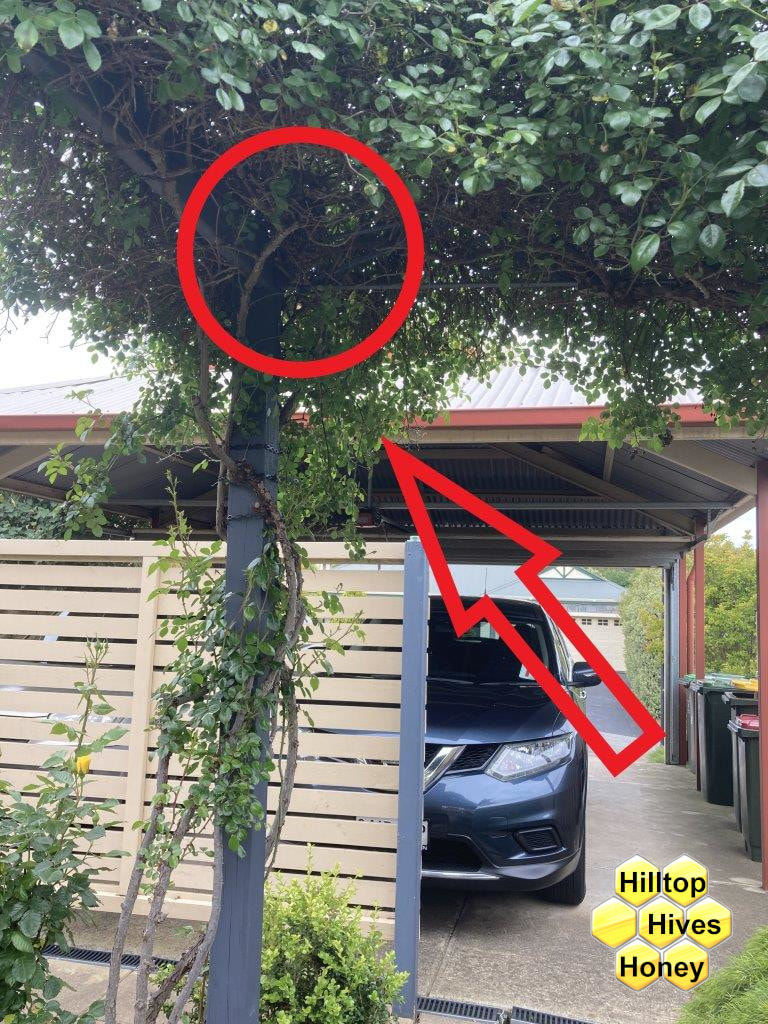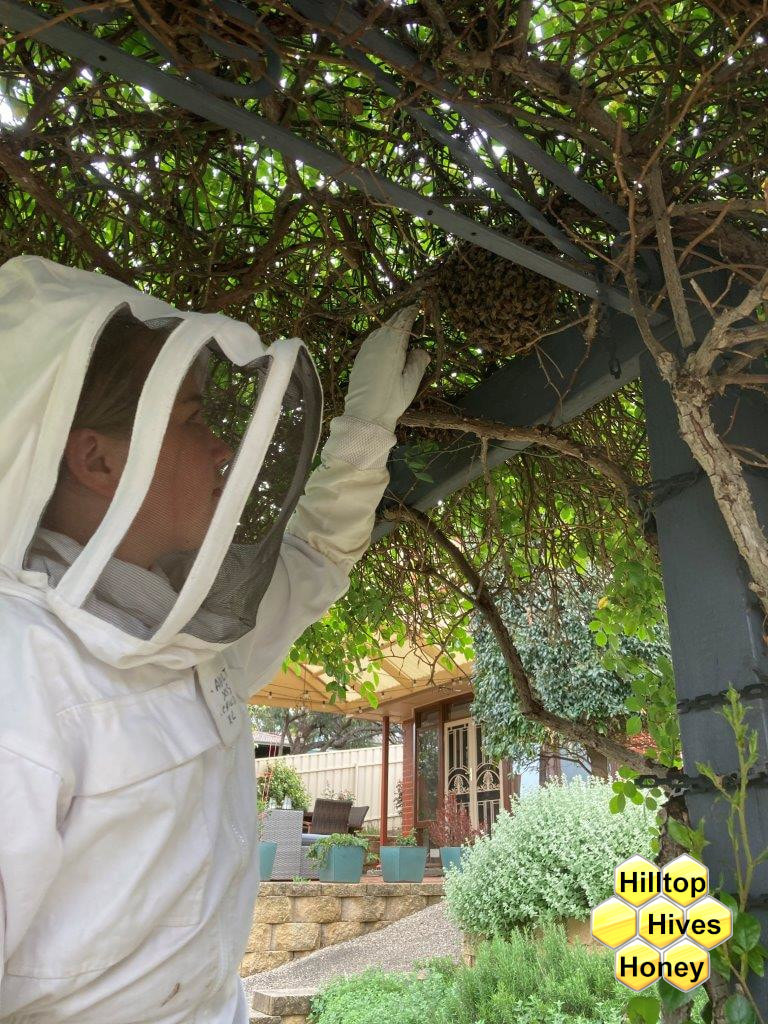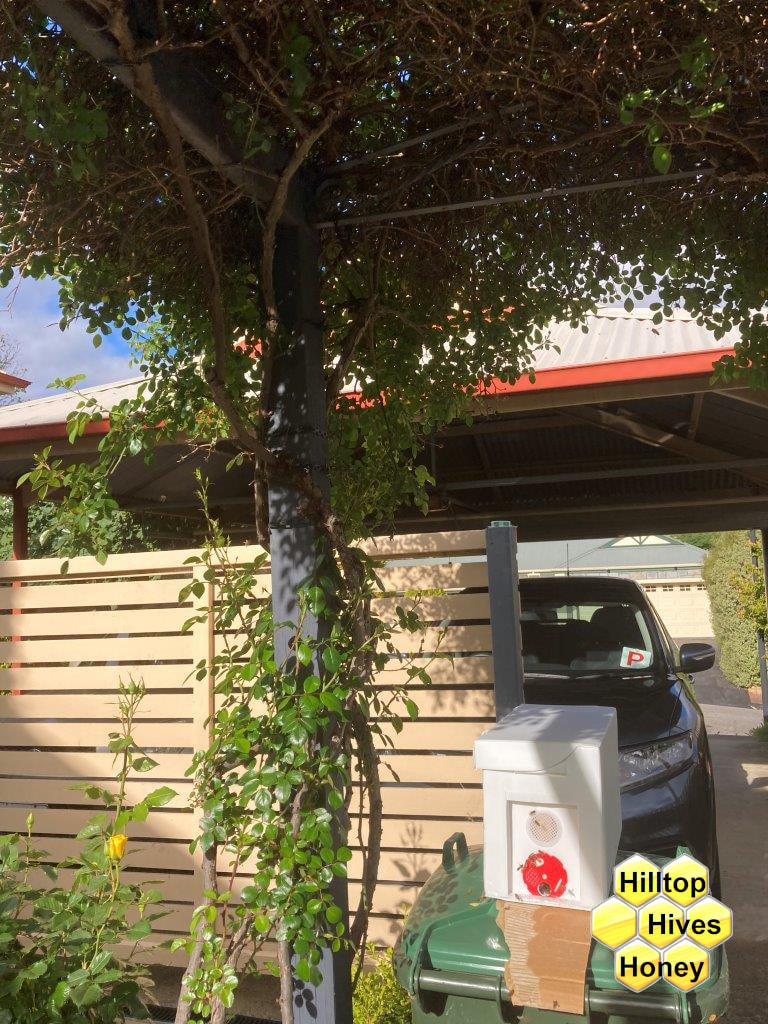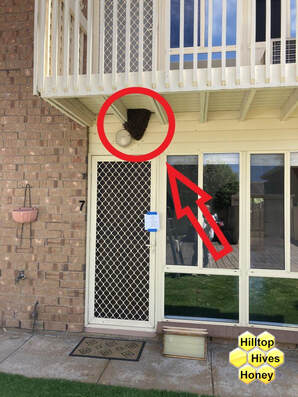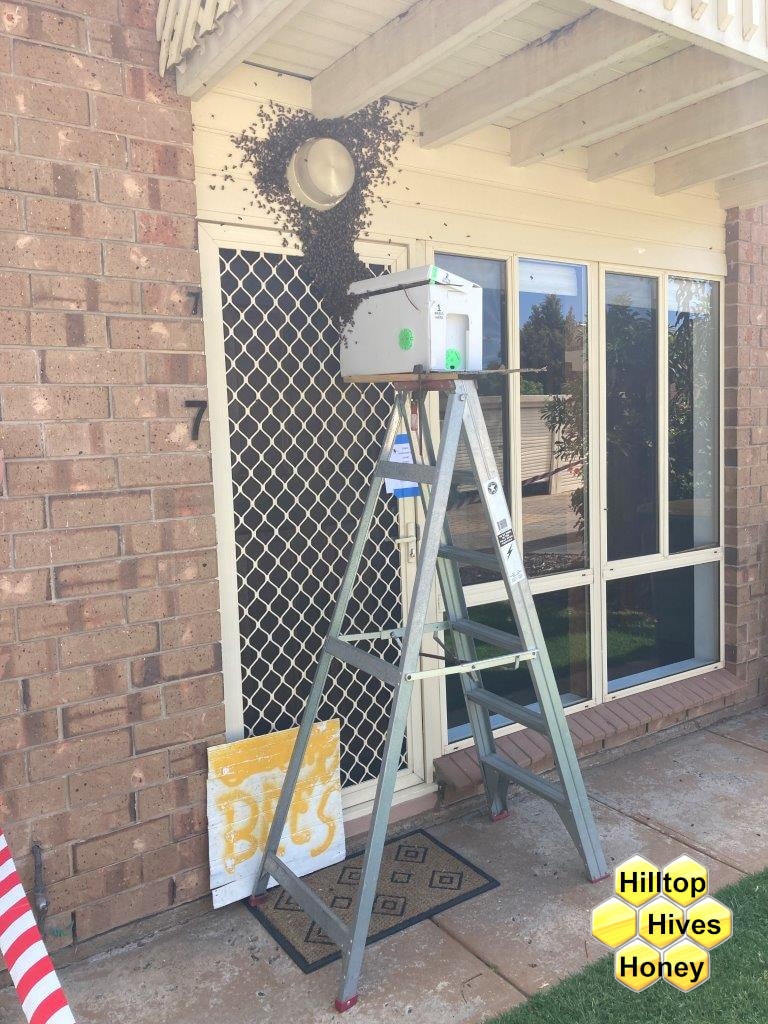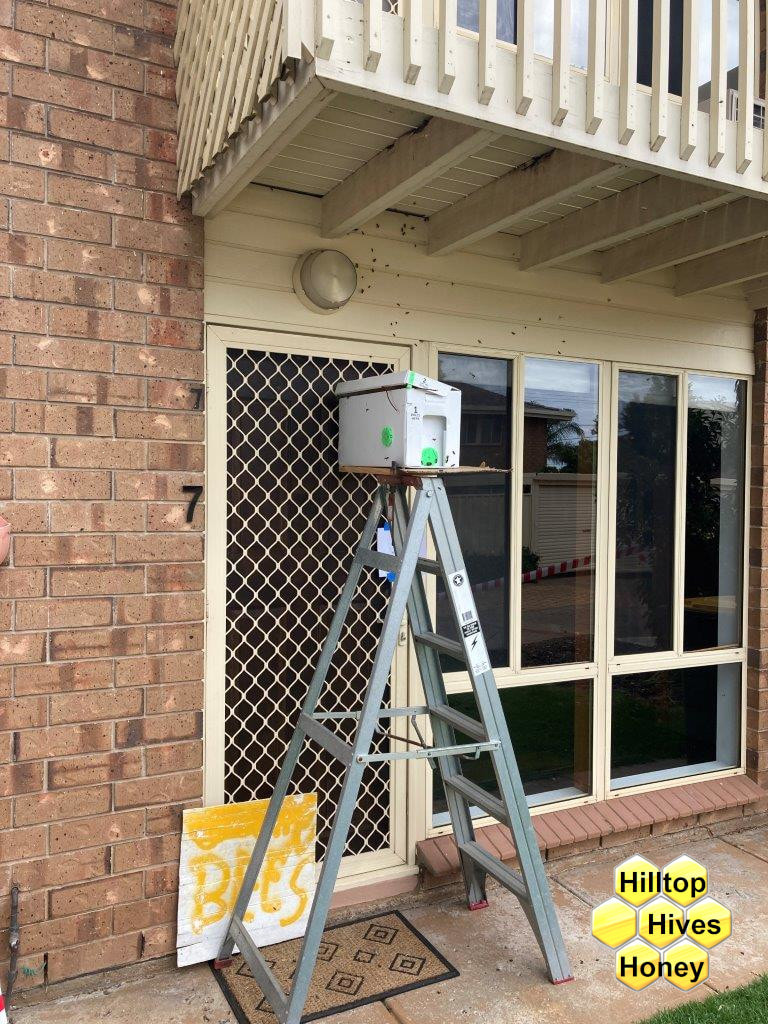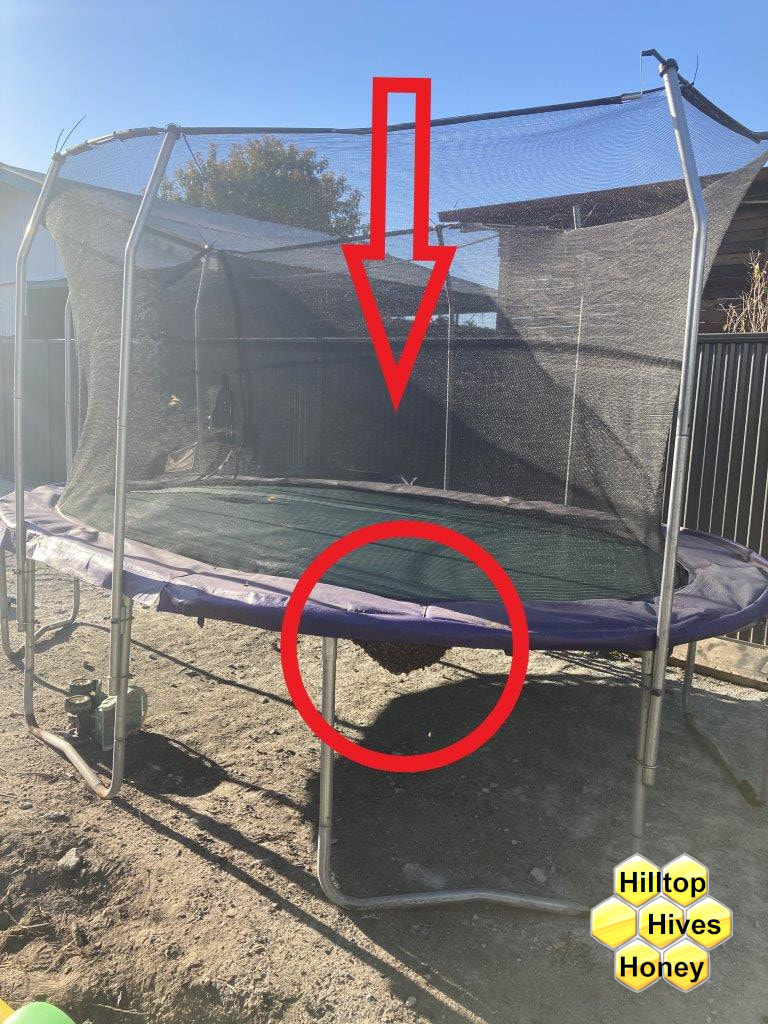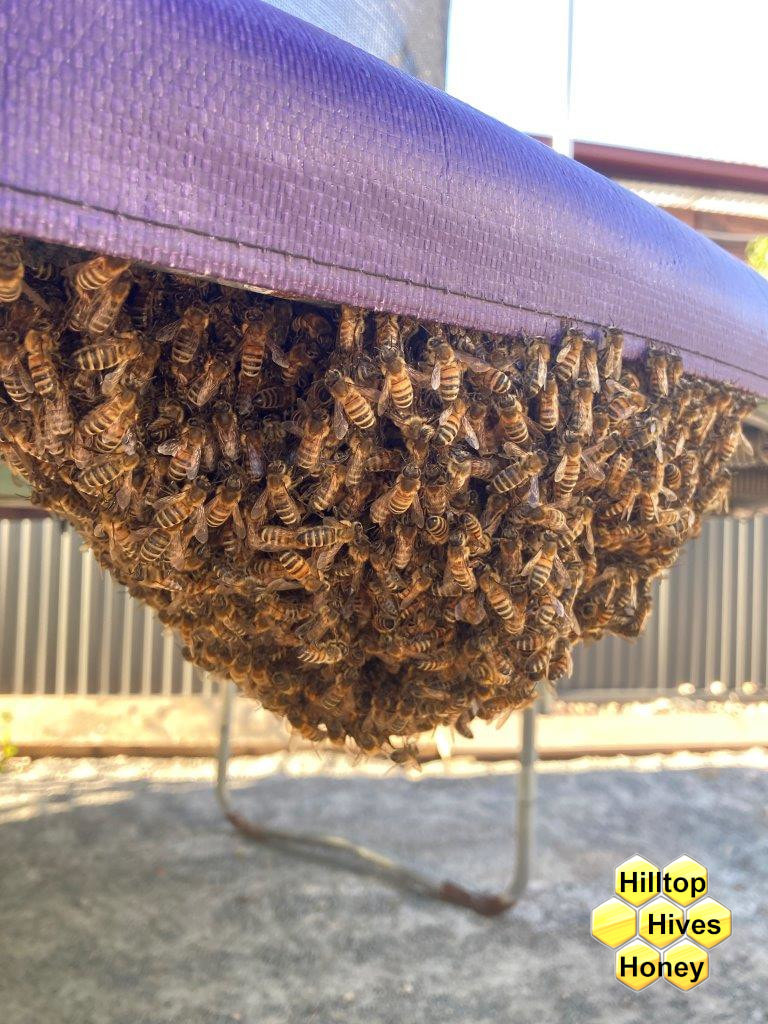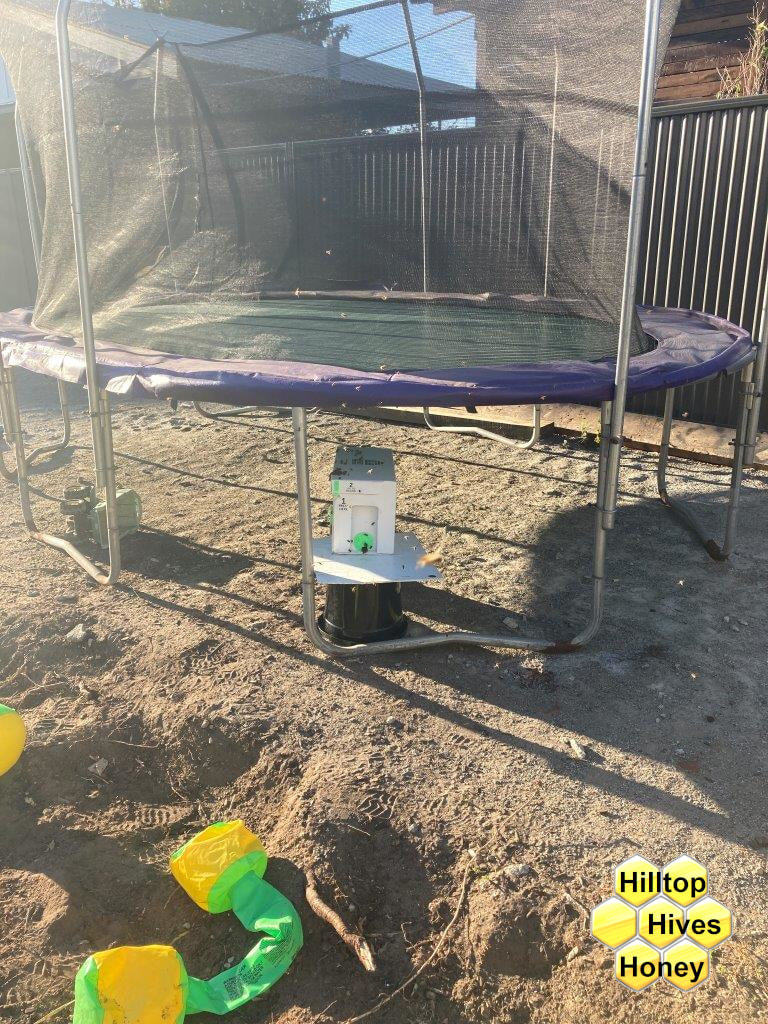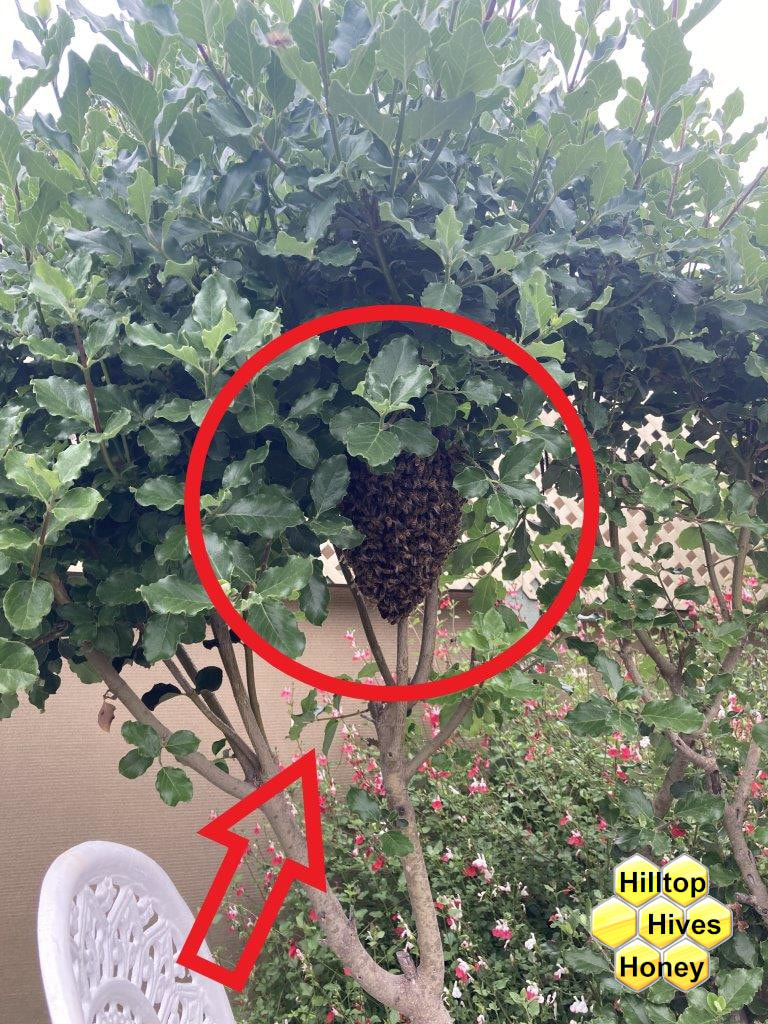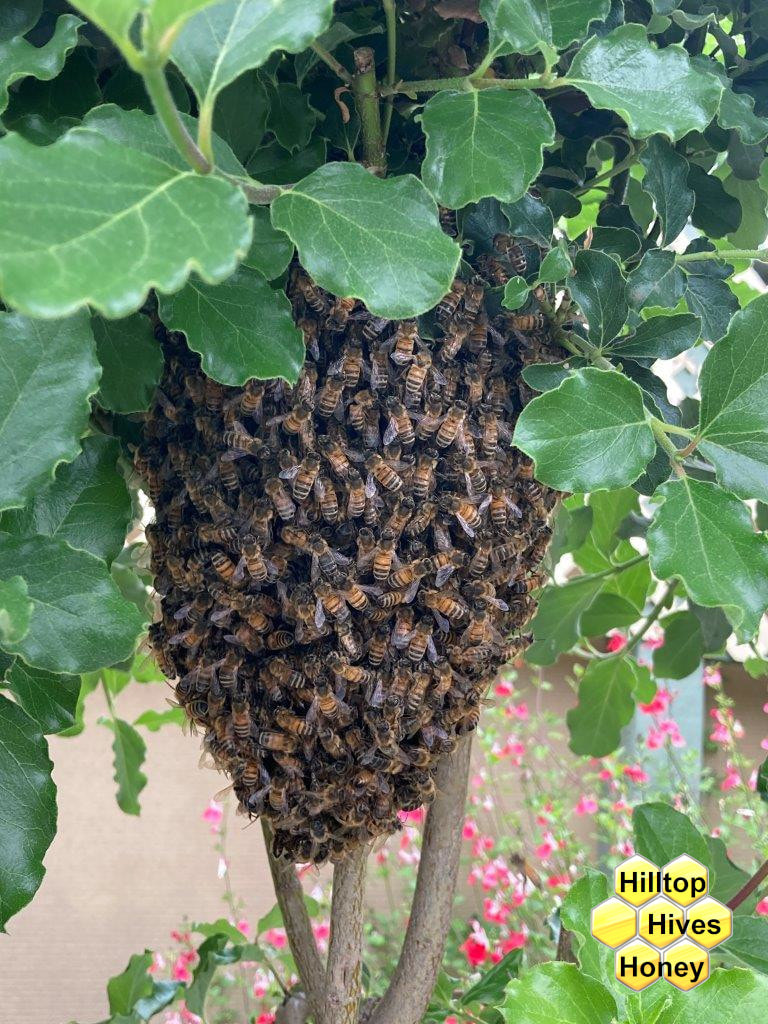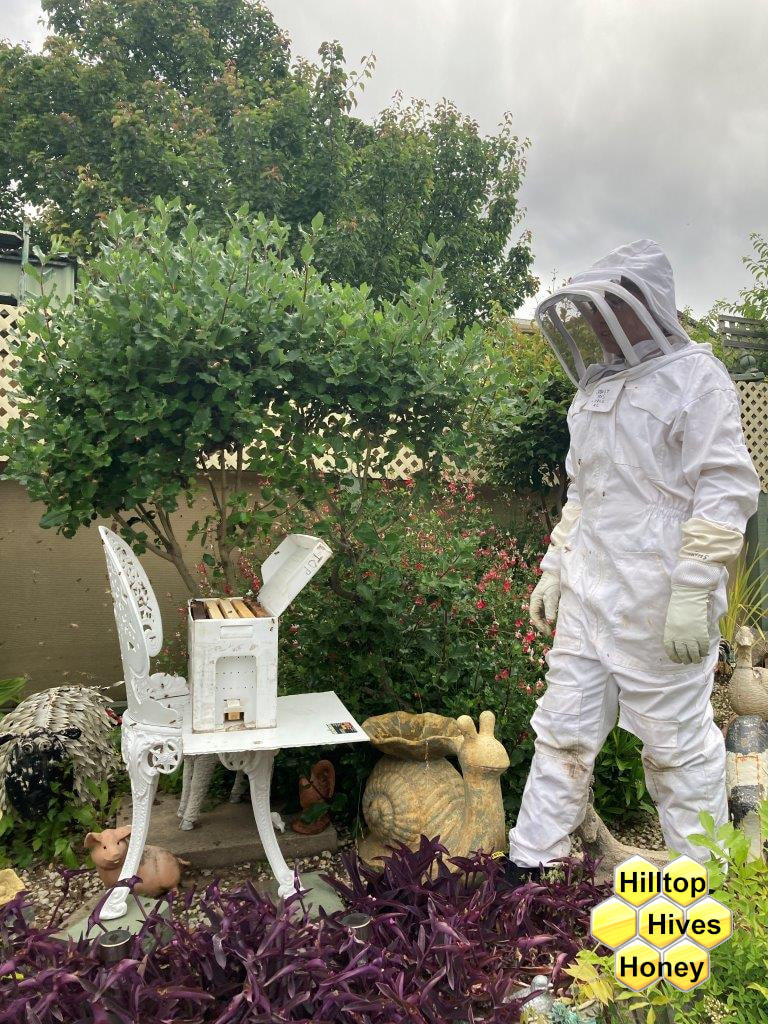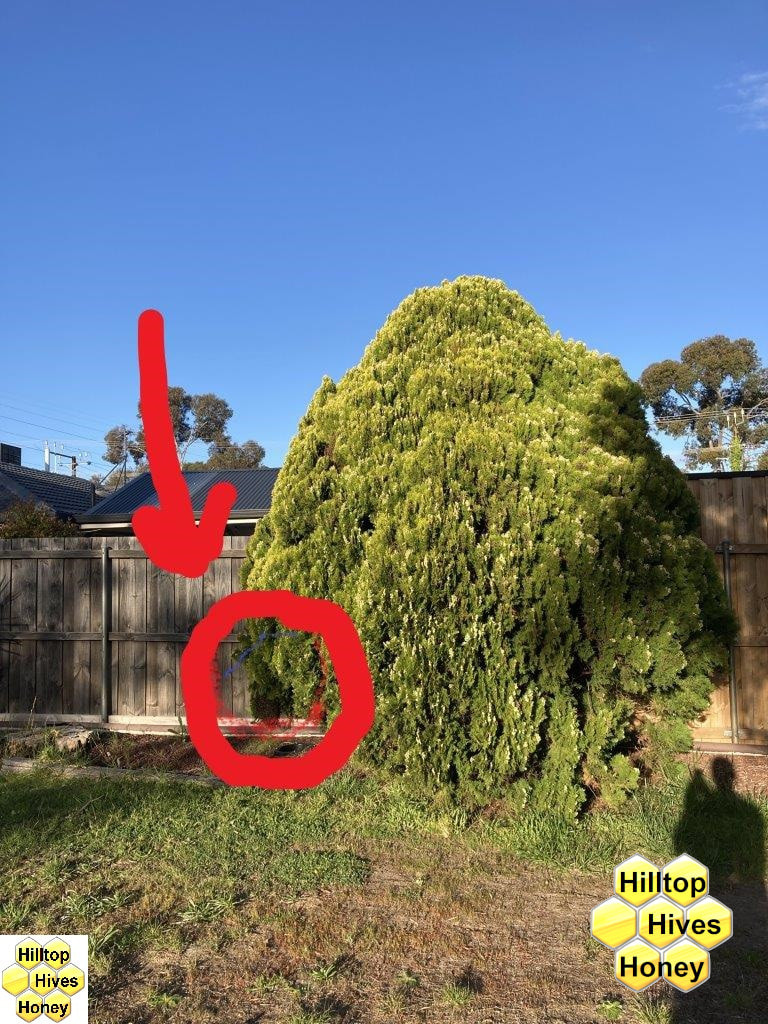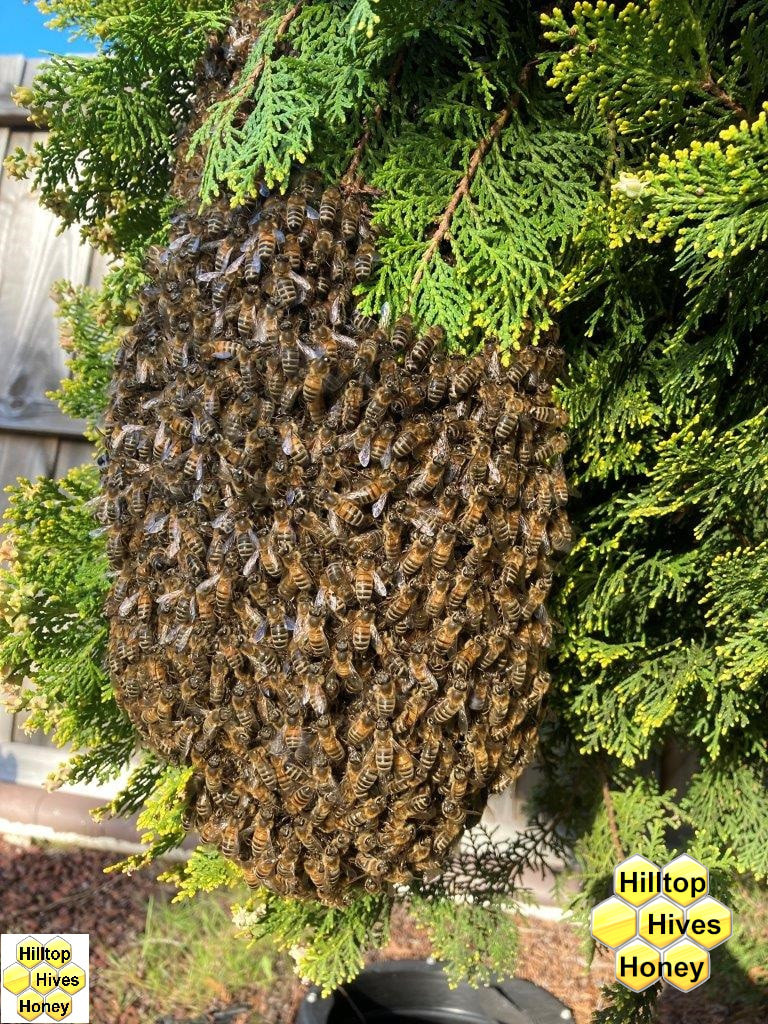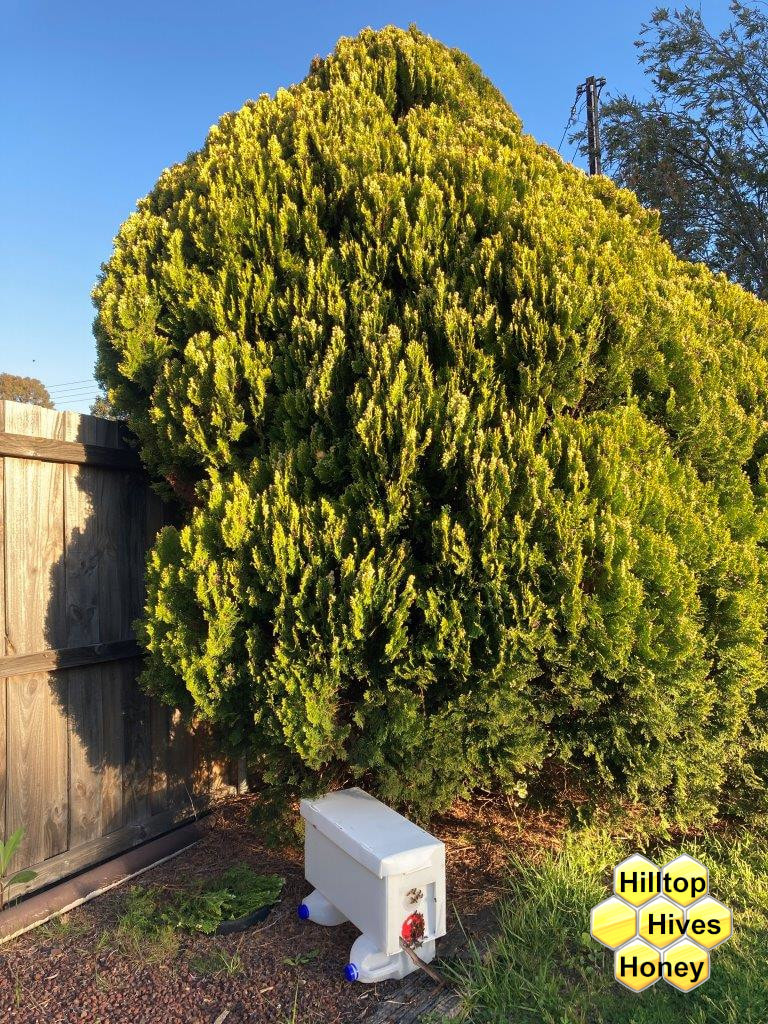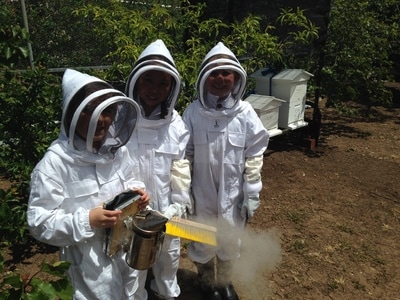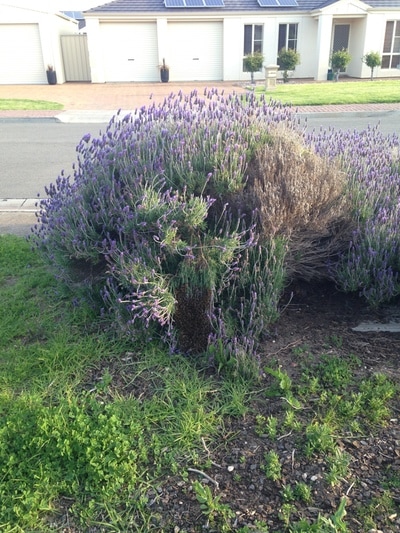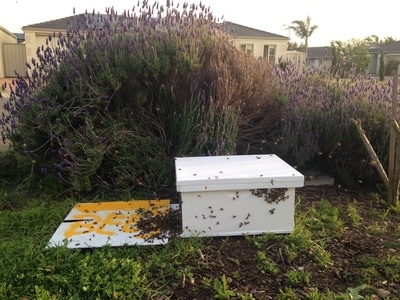Bee Swarm Removal
|
Bees swarm when their home is overcrowded.
Every Spring, bees may decide to leave a perfectly comfortable, but overcroweded hive, to find a new home, this is called 'swarming'. When bees swarm and fly nearby, you may hear them coming because of their loud buzz as they fly around, or you may see them swirling around madly in the sky, like a big dark crazy storm of bees in the air. Soon the bee swarm will settle on something, it could be a tree, your car, a rubbish bin, in fact anything will do! Then the bee swarm will send out their scouts to find a comfortable new home. Think of it like they are looking for new accomdation, something perfect for their massive family to live in! While the scouts are looking, the bees all form a ball of bee-ness to protect the Queen bee. Yes, she will be somewhere in the middle of the ball of bees! It's at this point, that the bees might decide to start building their new home, if they like the place where they have landed their swarm on. In less than 8 hours the bees can start building their wax honeycomb house, within 24 hours worker bees will start storing nectar and pollen in the newly build honeycome cells, and within 14 days, the Queen bee can start laying eggs in the honeycombe cells. Our Bee Swarm Capture and Removal Service
Catching Swarms is usually pretty straight forward, as you can see from some of the photos below. But some times they can be in hard to reach difficult places and it takes more effort, time and skill to capture and remove the swarm. Here's how it works:
Before you call Hilltop Hives and Honey about your bee swarm...
Question? Is the swarm on your property, and within 10km of the roundabout at Flagstaff Hill? If your swarm is within 10 kms of the intersection of Blacks, Road, Flagstaff Road and Happy Valley Drive, Flagstaff Hill, Yes = call us 0419 909 285 to find out if we are available to remove the bees for you. Check the Google map below. |
Stay Calm or Buzz Off ?!
The bee swarm might stay there for a day or so, or they might move on after a few minutes. Those swarming bees are simply looking for a suitable place to call home! Do you have a swarm of bees that are bothering you?
Bee Swarms on Public Land? If it's on public land, like a public footpath, park, or playground, please contact your local city council and they can usually arrange for the bee swarm to be removed free of charge. If you are in South Australia, click here to find the phone number for your local Council. Bee Swarms on your property? Call Hilltop Hives SA on 0419 909 285 when you need a bee swarm caught and removed. Read more about our swarm capture and Bee Swarm Removal services here on this web page. If you can't get hold of us at Hilltop Hives you could also try:
The SwarmPatrol web site facilitates a very fast notification of any swarms or feral colonies, which can then be collected by Beekeepers to be relocated. The very powerful Geopositioning function of SwarmPatrol.com enables the closest Beekeepers to the bee swarm to be notified by a text message to their mobile phones, thus guaranteeing the quickest possible response for the convenience the private property owner. The SwarmPatroller will make contact with the person reporting the swarm and will arrange for the removal of it either at no charge or at a mutually agreeable fee. Bee Swarm Removal Quotes
Feel free to send lots of photos of the swarm to us at Hilltop Hives and Honey SA, so we can assess the nature of it and give you a quote before we come out. Read below to find out more about our fees, Send your swarm photos to 0419 909 285
|
Call us on 0419 909 285 when you need a bee swarm caught and removed*.
After the sun goes down and all the bees are in the box, we will close the door and take them to one of our apiaries in the Adelaide Hills.
Later they will get them rehoused into a nice wooden bee hive box.
After the sun goes down and all the bees are in the box, we will close the door and take them to one of our apiaries in the Adelaide Hills.
Later they will get them rehoused into a nice wooden bee hive box.
Bee Swarm Removal Fees
For example, if we can easily access the bees, while standing on level ground, that would be a Easy Bee Swarm Removal
Fee = $125 cash on the day.
Depending on the complexity, the fee might be about $150 to $250 to give you a rough idea.
Send us photos of your bees and we can give you a free quote.
Call us on 0419 909 285 when you need a bee swarm caught and removed.
- Easy Bee Swarm Removal:
For example, if we can easily access the bees, while standing on level ground, that would be a Easy Bee Swarm Removal
Fee = $125 cash on the day.
- Complex Bee Swarm Removal
Depending on the complexity, the fee might be about $150 to $250 to give you a rough idea.
Send us photos of your bees and we can give you a free quote.
Call us on 0419 909 285 when you need a bee swarm caught and removed.
How to Keep Honey Bees from Nesting in your Home.
Has a swarm of bees landed at your house?
Here's what to do.
Spring, warmer weather and good flower blooms, are all signs that a bee hive might be operating at full capacity and the population in the hive might be too big for everyone to fit in there, almost overcrowded. The old queen knows this and soon enough bees swarm out of their existing hive, sometimes taking up to 60% of the worker bees with them.
This swarming action puts many homeowners at risk of obtaining unwanted beehives on their properties.
The departing group of bees will be on the hunt for a suitable area to nest (we call it ‘making a new hive’) - which can sometimes be in your home. Structures, buildings, and other objects that provide shelter on a property can become new homes for bee colonies.
While a swarm is on your property, your home is in jeopardy.
The group of bees will either temporarily rest and move on, or they’ll find an accommodating spot and declare your property as their permanent nesting location.
Some things to know about swarms.
Here's what to do.
Spring, warmer weather and good flower blooms, are all signs that a bee hive might be operating at full capacity and the population in the hive might be too big for everyone to fit in there, almost overcrowded. The old queen knows this and soon enough bees swarm out of their existing hive, sometimes taking up to 60% of the worker bees with them.
This swarming action puts many homeowners at risk of obtaining unwanted beehives on their properties.
The departing group of bees will be on the hunt for a suitable area to nest (we call it ‘making a new hive’) - which can sometimes be in your home. Structures, buildings, and other objects that provide shelter on a property can become new homes for bee colonies.
While a swarm is on your property, your home is in jeopardy.
The group of bees will either temporarily rest and move on, or they’ll find an accommodating spot and declare your property as their permanent nesting location.
Some things to know about swarms.
- They form into a kind of round ball, usually about the size of a football, while scout bees continue looking for a good home site. Once the scouts find suitable accommodation they return to the swarm and let them know the directions to the new hive home site and the swarm will fly off in a big messy cloud of noisy bees to the new home, or,
- The bees decide the new place is a good home and they start making wax honeycomb pretty much straight away and really make themselves at home. They settle in there for good, if you don't get them removed asap!
Bees are going into my walls/roof/air vent!!
If the bees are actually entering into the wall or roof of you house, it's too late, the swarm is settling in to stay!
Once the queen bee is in the wall cavity, roof or internal parts of your house, it's almost impossible to get the swarm out unless you deconstruct that part of the house. Most home owner would find the deconstruction of part of their house too expensive. Here's where you need a bit of pragmatic reality. We all want to save the bees, but at what cost? You'll have to weigh up the $1,000s of dollars it will cost to deconstruct part of your house to remove a swarm, verses the much lower cost of getting a pest controller into poison the bees.
WE CAN'T GET BEES OUT OF YOUR WALLS, ROOF OR AIR VENTS!
Word of warning!
Swarming bees love to move into places where other bees have lived in the past. If swarming bees pass a location and it “smells like home,” they will move in, the queen will start laying eggs, and you think the old bees “returned.” Nope, this is a new swarm that likes the same things about the home as the previous swarm did and they've just found a house that suits them.
Protecting your Home from Unwanted Beehives
Bees can enter any structure or object that contains a hole that is a 12mm or larger.
A common bee prevention technique is to seal all potential bee entries with durable materials, like metal fly screen, caulk or expanding foam sealer.
However, once a swarm is on your property, you may not have sufficient time to identify and seal all of the potential entry points for the bees.
Also, if your home has previously had problems with honey bees, make sure all the honeycomb is removed. The pheromone scents left on honeycomb can attract newcomers. Usually the honeycomb will be situated in an inaccessible area (wall voids, eaves, etc.), so removing portions of your roof or wall coverings may be necessary.
Save yourself a lot of hassle and expense, seal up small gaps and call a bee keeper as soon as you see a swarm at your property!
If the bees are actually entering into the wall or roof of you house, it's too late, the swarm is settling in to stay!
Once the queen bee is in the wall cavity, roof or internal parts of your house, it's almost impossible to get the swarm out unless you deconstruct that part of the house. Most home owner would find the deconstruction of part of their house too expensive. Here's where you need a bit of pragmatic reality. We all want to save the bees, but at what cost? You'll have to weigh up the $1,000s of dollars it will cost to deconstruct part of your house to remove a swarm, verses the much lower cost of getting a pest controller into poison the bees.
WE CAN'T GET BEES OUT OF YOUR WALLS, ROOF OR AIR VENTS!
Word of warning!
Swarming bees love to move into places where other bees have lived in the past. If swarming bees pass a location and it “smells like home,” they will move in, the queen will start laying eggs, and you think the old bees “returned.” Nope, this is a new swarm that likes the same things about the home as the previous swarm did and they've just found a house that suits them.
Protecting your Home from Unwanted Beehives
Bees can enter any structure or object that contains a hole that is a 12mm or larger.
A common bee prevention technique is to seal all potential bee entries with durable materials, like metal fly screen, caulk or expanding foam sealer.
However, once a swarm is on your property, you may not have sufficient time to identify and seal all of the potential entry points for the bees.
Also, if your home has previously had problems with honey bees, make sure all the honeycomb is removed. The pheromone scents left on honeycomb can attract newcomers. Usually the honeycomb will be situated in an inaccessible area (wall voids, eaves, etc.), so removing portions of your roof or wall coverings may be necessary.
Save yourself a lot of hassle and expense, seal up small gaps and call a bee keeper as soon as you see a swarm at your property!
Bees in tricky places like walls or chimneys, inside trees, bird boxes and possum boxes?
We don't get bees out of :
we don't do it.
When bees are in places like chimneys and walls, there's a lot more risks involved in attempting to remove them.
Some risks are:
Bees in walls or chimneys = we’ll most likely recommend that you:
- reducing the number of wild swarms is actually good for the general bee population,
- consider calling a pest control service to get the bees exterminated,
- don't worry too much about feeling bad about the bees, there's usually lots of other bees swarming wildly in Adelaide at the same time, and
- safely block the bees access to the walls, so that next swarm season you don't get more bees looking for a new home in your walls.
Call us on 0419 909 285 when you need a bee swarm caught and removed.
We don't get bees out of :
- walls
- chimneys
- roofs
- inside trees
- bird boxes,
- possum boxes.
we don't do it.
When bees are in places like chimneys and walls, there's a lot more risks involved in attempting to remove them.
Some risks are:
- working at heights without adequate insurance,
- doing building disassembly that we are not qualified for,
- no way to guarantee that we can get the Queen bee and the other bees out,
- we might damage your property,
- we are not qualified to rebuild it, and
- it will probably cost you a lot of money $$$$ for a beekeeper to remove the bees.
Bees in walls or chimneys = we’ll most likely recommend that you:
- reducing the number of wild swarms is actually good for the general bee population,
- consider calling a pest control service to get the bees exterminated,
- don't worry too much about feeling bad about the bees, there's usually lots of other bees swarming wildly in Adelaide at the same time, and
- safely block the bees access to the walls, so that next swarm season you don't get more bees looking for a new home in your walls.
Call us on 0419 909 285 when you need a bee swarm caught and removed.
